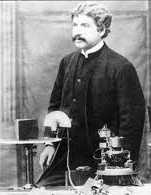-
(b.) -1858 November 30(d.)1937 November 23
Bio/Description
A Bengali polymath: a physicist, biologist, botanist, archaeologist, as well as an early writer of science fiction, he pioneered the investigation of radio and microwave optics, made very significant contributions to plant science, and laid the foundations of experimental science in the Indian subcontinent. IEEE named him one of the fathers of radio science. He is also considered the father of Bengali science fiction. He was the first person from the Indian subcontinent to receive a US patent, in 1904. Born during the British Reign, he graduated from St. Xavier's College, Calcutta. He then went to the University of London to study medicine, but could not pursue studies in medicine due to health problems. Instead, he conducted his research with the Nobel Laureate Lord Rayleigh at Cambridge and returned to India. He then joined the Presidency College of University of Calcutta as a professor of Physics. There, despite racial discrimination and a lack of funding and equipment, he carried on his scientific research. He made remarkable progress in his research of remote wireless signaling and was the first to use semiconductor junctions to detect radio signals. However, instead of trying to gain commercial benefit from this invention he made his inventions public in order to allow others to further develop his research. Moreover, the policy of the British government for its colonies was not conducive to attempts at original research. He spent his hard-earned money for making experimental equipment. Within a decade of his joining Presidency College, he emerged a pioneer in the incipient research field of wireless waves.
He subsequently made a number of pioneering discoveries in plant physiology. He used his own invention, the crescograph, to measure plant response to various stimuli, and thereby scientifically proved parallelism between animal and plant tissues.
Although he filed for a patent for one of his inventions due to peer pressure, his reluctance to any form of patenting was well known.
It appears that his demonstration of remote wireless signalling has priority over Marconi. He was the first to use a semiconductor junction to detect radio waves, and he invented various now commonplace microwave components. In 1954, Pearson and Brattain gave priority to him for the use of a semi-conducting crystal as a detector of radio waves. Further work at millimetre wavelengths was almost nonexistent for nearly 50 years. In 1897, he described to the Royal Institution in London his research carried out in Kolkata at millimetre wavelengths. He used waveguides, horn antennas, dielectric lenses, various polarisers and even semiconductors at frequencies as high as 60 GHz; much of his original equipment is still in existence, now at the Bose Institute in Kolkata. A 1.3 mm multi-beam receiver now in use on the NRAO 12 Metre Telescope, Arizona, USA, incorporates concepts from his original 1897 papers. Sir Nevill Mott, Nobel Laureate in 1977 for his own contributions to solid-state electronics, remarked that "J.C. Bose was at least 60 years ahead of his time" and "In fact, he had anticipated the existence of P-type and N-type semiconductors."
-
Date of Birth:
1858 November 30 -
Date of Death:
1937 November 23 -
Gender:
Male -
Noted For:
IEEE named him one of the fathers of radio science -
Category of Achievement:
-
More Info:


